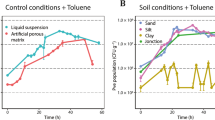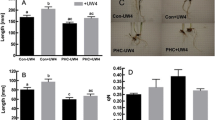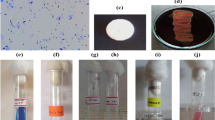Abstract
We used a microarray targeting 3,524 genes to assess the transcriptional response of the actinomycete Rhodococcus aetherivorans I24 in minimal medium supplemented with various substrates (e.g., PCBs) and in both PCB-contaminated and non-contaminated sediment slurries. Relative to the reference condition (minimal medium supplemented with glucose), 408 genes were upregulated in the various treatments. In medium and in sediment, PCBs elicited the upregulation of a common set of 100 genes, including gene-encoding chaperones (groEL), a superoxide dismutase (sodA), alkyl hydroperoxide reductase protein C (ahpC), and a catalase/peroxidase (katG). Analysis of the R. aetherivorans I24 genome sequence identified orthologs of many of the genes in the canonical biphenyl pathway, but very few of these genes were upregulated in response to PCBs or biphenyl. This study is one of the first to use microarrays to assess the transcriptional response of a soil bacterium to a pollutant under conditions that more closely resemble the natural environment. Our results indicate that the transcriptional response of R. aetherivorans I24 to PCBs, in both medium and sediment, is primarily directed towards reducing oxidative stress, rather than catabolism.

Similar content being viewed by others
Abbreviations
- PCBs:
-
Polychlorinated biphenyls
- GLU:
-
Glucose control
- BP:
-
Biphenyl
- C:
-
Contaminated sediment
- NC:
-
Non-contaminated sediment
- LB:
-
Luria–Bertani Broth
- MM:
-
Minimal medium
- PBS:
-
Phosphate-buffered saline
- COG:
-
Cluster of orthologous groups of proteins
References
Agulló L, Cámara B, Martínez P, Latorre V, Seeger M (2007) Response to (chloro)biphenyls of the polychlorobiphenyl-degrader Burkholderia xenovorans LB400 involves stress proteins also induced by heat shock and oxidative stress. FEMS Microbiol Lett 267:167–175
Asturias J, Eltis L, Prucha M, Timmis K (1994) Analysis of three 2, 3-dihydroxybiphenyl 1, 2-dioxygenases found in Rhodococcus globerulus P6. Identification of a new family of extradiol dioxygenases. J Biol Chem 269:7807–7815
Bell KS, Philp JC, Aw DWJ, Christofi N (1998) A review—the genus Rhodococcus. J Appl Microbiol 85:195–210
Bolstad B, Irizarry R, Astrand M, Speed T (2003) A comparison of normalization methods for high density oligonucleotide array data based on variance and bias. Bioinformatics 19:185–193
Bopp L (1986) Degradation of highly chlorinated PCBs by Pseudomonas strain LB400. J Ind Microbiol Biotec 1:23–29
Buterin T, Koch C, Naegeli H (2005) Potential application of gene expression fingerprinting for food safety screening. Anal Chim Acta 529:33–39
Chartrain M, Jackey B, Taylor C, Sandford V, Gbewonyo K, Lister L, Dimichele L, Hirsch C, Heimbuch B, Maxwell C, Pascoe D, Buckland B, Greasham R (1998) Bioconversion of indene to cis (1S, 2R) indandiol and trans (1R, 2R) indandiol by Rhodococcus species. J Ferment Bioeng 86:550–558
Chávez F, Lünsdorf H, Jerez C (2004) Growth of polychlorinated-biphenyl-degrading bacteria in the presence of biphenyl and chlorobiphenyls generates oxidative stress and massive accumulation of inorganic polyphosphate. Appl Environ Microbiol 70:3064–3072
Denef V, Park J, Tsoi T, Rouillard J, Zhang H, Wibbenmeyer J, Verstraete W, Gulari E, Hashsham S, Tiedje J (2004) Biphenyl and benzoate metabolism in a genomic context: outlining genome-wide metabolic networks in Burkholderia xenovorans LB400. Appl Environ Microbiol 70:4961–4970
Denef V, Patrauchan M, Florizone C, Park J, Tsoi T, Verstraete W, Tiedje J, Eltis L (2005) Growth substrate–and phase-specific expression of biphenyl, benzoate, and C1 metabolic pathways in Burkholderia xenovorans LB400. J Bacteriol 187:7996–8005
Duintjer J, Eisma M (2000) Milieu-aspecten onderhoudsbaggerspecie. Resultaten monstercampagne 2000. Gemeentelijk Havenbedrijf Rotterdam/ RWS Directie Zuid-Holland: 13
Gonçalves E, Hara H, Miyazawa D, Davies J, Eltis L, Mohn W (2006) Transcriptomic assessment of isozymes in the biphenyl pathway of Rhodococcus sp. strain RHA1. Appl Environ Microbiol 72:6183–6193
Hrywna Y, Tsoi T, Maltseva O, Jr Q, Tiedje J (1999) Construction and characterization of two recombinant bacteria that grow on ortho–and para-substituted chlorobiphenyls. Appl Environ Microbiol 65:2163–2169
Inaoka T, Matsumura Y, Tsuchido T (1999) SodA and manganese are essential for resistance to oxidative stress in growing and sporulating cells of Bacillus subtilis. J Bacteriol 181:1939–1943
Irizarry R, Hobbs B, Collin F, Beazer-Barclay Y, Antonellis K, Scherf U, Speed T (2003) Exploration, normalization, and summaries of high density oligonucleotide array probe level data. Biostatistics 4:249–264
Jensen L, Julien P, Kuhn M, von Mering C, Muller J, Doerks T, Bork P (2008) eggNOG: automated construction and annotation of orthologous groups of genes. Nucleic Acids Res 36:D250–D254
Layton AC, Muccini M, Ghosh MM, Sayler GS (1998) Construction of a bioluminescent reporter strain to detect polychlorinated biphenyls. Appl Environ Microbiol 64:5023–5026
Liu XM, Germaine KJ, Ryan D, Dowling DN (2007) Development of a Gfp-based biosensor for detecting the bioavailability and biodegradation of polychlorinated biphenyls (PCBs). J Environ Eng Landsc 15:261–268
O'Brien XM, Parker JA, Lessard PA, Sinskey AJ (2002) Engineering an indene bioconversion process for the production of cis-aminoindanol: a model system for the production of chiral synthons. Appl Microbiol Biot 59:389–399
Ohtsubo Y, Kudo T, Tsuda M, Nagata Y (2004) Strategies for bioremediation of polychlorinated biphenyls. Appl Microbiol Biot 65:250–258
Parnell J, Park J, Denef V, Tsoi T, Hashsham S, Quensen JR, Tiedje J (2006) Coping with polychlorinated biphenyl (PCB) toxicity: Physiological and genome-wide responses of Burkholderia xenovorans LB400 to PCB-mediated stress. Appl Environ Microbiol 72:6607–6614
Pieper D, Seeger M (2008) Bacterial metabolism of polychlorinated biphenyls. J Mol Microbiol Biot 15:121–138
Priefert H, O'Brien X, Lessard P, Dexter A, Choi E, Tomic S, Nagpal G, Cho J, Agosto M, Yang L, Treadway S, Tamashiro L, Wallace M, Sinskey A (2004) Indene bioconversion by a toluene inducible dioxygenase of Rhodococcus sp. I24. Appl Microbiol Biotec 65:168–176
Puglisi E, Murk A, van den Berg H, Grotenhuis T (2007) Extraction and bioanalysis of the ecotoxicologically relevant fraction of contaminants in sediments. Environ Toxicol Chem 26:2122–2128
Ritz D, Patel H, Doan B, Zheng M, Aslund F, Storz G, Beckwith J (2000) Thioredoxin 2 is involved in the oxidative stress response in Escherichia coli. J Biol Chem 275:2505–2512
Rodrigues J, Kachel C, Aiello M, Quensen J, Maltseva O, Tsoi T, Tiedje J (2006) Degradation of aroclor 1242 dechlorination products in sediments by Burkholderia xenovorans LB400(ohb) and Rhodococcus sp. strain RHA1(fcb). Appl Environ Microbiol 72:2476–2482
Rumpel C, Dignac MF (2006) Chromatographic analysis of monosaccharides in a forest soil profile: Analysis by gas chromatography after trifluoroacetic acid hydrolysis and reduction-acetylation. Soil Biol Biochem 38:1478–1481
Sakai M, Miyauchi K, Kato N, Masai E, Fukuda M (2003) 2-Hydroxypenta-2, 4-dienoate metabolic pathway genes in a strong polychlorinated biphenyl degrader, Rhodococcus sp. strain RHA1. Appl Environ Microbiol 69:427–433
Seaver L, Imlay J (2001) Alkyl hydroperoxide reductase is the primary scavenger of endogenous hydrogen peroxide in Escherichia coli. J Bacteriol 183:7173–7181
Seto M, Kimbara K, Shimura M, Hatta T, Fukuda M, Yano K (1995) A novel transformation of polychlorinated biphenyls by Rhodococcus sp. strain RHA1. Appl Environ Microbiol 61:3353–3358
Tatusov R, Fedorova N, Jackson J, Jacobs A, Kiryutin B, Koonin E, Krylov D, Mazumder R, Mekhedov S, Nikolskaya A, Rao B, Smirnov S, Sverdlov A, Vasudevan S, Wolf Y, Yin J, Natale D (2003) The COG database: an updated version includes eukaryotes. BMC Bioinformatics 4:41
Xing Y, Lu Y, Dawson R, Shi Y, Zhang H, Wang T, Liu W, Ren H (2005) A spatial temporal assessment of pollution from PCBs in China. Chemosphere 60:731–739
Yang XQ, Sun Y, Qian SJ (2004) Biodegradation of seven polychlorinated biphenyls by a newly isolated aerobic bacterium (Rhodococcus sp R04). J Ind Microbiol Biotechnol 31:415–420
Zamocky M, Furtmüller P, Obinger C (2008) Evolution of catalases from bacteria to humans. Antioxid Redox Signal 10:1527–1548
Zeller T, Klug G (2006) Thioredoxins in bacteria: functions in oxidative stress response and regulation of thioredoxin genes. Naturwissenschaften 93:259–266
Zhou JZ, Thompson DK (2002) Challenges in applying microarrays to environmental studies. Curr Opin Biotechnol 13:204–207
Acknowledgements
This work was supported by IRG Marie Curie Grant “COMEHERE,” contract No. 21634, and by the Cambridge–MIT Institute.
Author information
Authors and Affiliations
Corresponding author
Electronic supplementary material
Below is the link to the electronic supplementary material.
Table S1
(XLS 94 kb)
Rights and permissions
About this article
Cite this article
Puglisi, E., Cahill, M.J., Lessard, P.A. et al. Transcriptional Response of Rhodococcus aetherivorans I24 to Polychlorinated Biphenyl-Contaminated Sediments. Microb Ecol 60, 505–515 (2010). https://doi.org/10.1007/s00248-010-9650-5
Received:
Accepted:
Published:
Issue Date:
DOI: https://doi.org/10.1007/s00248-010-9650-5




